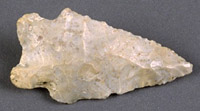|
(Text that appears in red indicates basic characteristics of the various
culture periods. Text in blue denotes important additional details.)
As the Ice Age ended, great lakes covered large portions of the valley.
Archaeological evidence reveals that from around 8,000 to 6,000 BCE,
many people camped around the shores of these lakes. Groundstone implements
used for processing plant materials found on these ancient lake terrace
sites indicate increased dependence on plants as food
sources. However,
hunting remained important. Changes in projectile point shapes, sizes,
weights, and hafting methods signify technological
changes in weaponry.
These early settlers of the Antelope Valley hunted faster
and smaller "modern" species
such as deer and antelope, along with small mammals, fish, and water
fowl. There has long been speculation that these lake terrace inhabitants,
who formed the earliest "settlements" (long-term camps) in
California and the western Great Basin, may have been from, or ancestral
to, the Hokan linguistic family. (Present-day Hokan speakers include
such groups as the Chumash, Washoe, southern California Yuman groups,
and Pomo peoples.)
During a lengthy period beginning around 5,000 BCE, an episode of intense
climatic warming was responsible for
major changes in human settlement patterns and lifeways. The
large lakes dried up and their associated resources were gone. Inhabitants
were forced to seek living sites near
dependable water sources—springs, streams, or small, isolated
lakes. Larger groups began to establish more permanent settlements near
these less abundant water supplies, while foraging
for food (both plant
and
animal) in wide areas around these semi-permanent dwelling sites. Temporary
campsites were used for long-distance hunting and gathering forays, while
the larger residential sites were moved only when more promising dwelling
locations were found.
Plant processing continued to increase in importance
in everyday life.
The prominence of dart points (as opposed to the larger spear points
of previous periods) implies both improved hunting
technology and expanded variety in animal species hunted. As settlement patterns became more
sedentary, evidence of more complex social and religious patterns began
to emerge, including rock art related
to belief systems.
By 4,000 years ago, (around 2,000 BCE) people of the western Great Basin
were skilled in hunting and gathering strategies known as "seasonal
rounds." During any given year, groups would travel from permanent
or semi-permanent (winter) villages to temporary locations (or higher
elevation summer villages) to collect seasonally available plant and
animal food supplies. Perhaps as early as 1500 BCE, the acorn, obtained
from oak species in foothill canyons, had become the
major dietary staple in the Antelope Valley and other western Mojave Desert areas, as well
as in most of the Californian region. Seasonal subsistence techniques
remained in place in the Great Basin and California throughout the remaining
prehistoric and proto-historic periods.
From 2,000 BCE to CE 400/500, hunting weaponry took
on distinctive characteristics.
Stone projectile points for both darts and spears were carefully and
beautifully flaked from a wide variety of materials in a considerable
range of shapes. Among the most distinctive of these are the "Elko
Series" types. In addition to these more diagnostic forms, classic
lanceolate ("leaf" shaped) points (from earlier origins ) were
also prominent. Obsidian seems to have been a material of choice.

|

|
During this period, the mountain sheep was one of the animals of major
significance. Hunting camps, dating to from 4,000 to 5,000 years ago
and bearing mountain sheep remains, have been discovered at a variety
of mountain elevations (some as high as almost 13,000 feet above sea
level). Many prehistoric rock art sites in vicinities near Antelope Valley
dramatically emphasize mountain sheep figures and motifs. Although it
is generally accepted that these rock art expressions are ceremonially
linked to mountain sheep hunting cultures, researchers are in disagreement
regarding specific or intended meaning[s] of the images.
It is important to note that lifeways in Antelope Valley may have differed
in some respects from the classic Great Basin culture models, due to
two specific geographic characteristics: (1) the Antelope Valley provides
a natural access corridor that linked the California coast with early
trails that extended south to Mexico, north into California's Central
Valley, and east as far as the Southwest culture region. (2) The Antelope
Valley had an abundance of natural springs. This fortuitous combination
resulted in the flourishing of major trade and interaction
routes through the Antelope Valley as early as at least 3,000 to 4,000 years ago. Consequently,
a number of sizeable permanent villages persisted over several millennia,
because the Antelope Valley residents could take advantage
of both coastal and desert resources and adaptation. (Indeed they may have become somewhat
affluent "facilitators" in the extensive trade networking system
during that time.)

|

|
By approximately CE 400 to 500, Antelope Valley residents were more
dependent upon gathering than hunting. However, hunting itself had been
revolutionized by the introduction of bow
and arrow technology, which
largely (although not totally) replaced the use of spears and darts.
Markedly smaller projectile points (such as the Eastgate/Rose Springs
types) were clearly the dominant missiles from circa CE 500 through CE
800/ 900. The abundance and variety of stone implements in general, along
with food remains from archaeological sites dating to this period, attest
to intensive processing of both plant and animal resources.
To find related artifacts, SEARCH the collections
database. Antelope Valley Native American Peoples
Early Visitors << Previous |
Next: >> Late Prehistoric Period
|




